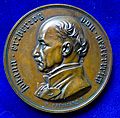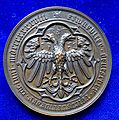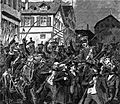Frankfurt Parliament facts for kids
The Frankfurt Parliament was a very important meeting in German history. It was the first time people from all over Germany could freely elect their representatives. This parliament met from May 18, 1848, to May 31, 1849. Their meetings took place in the Paulskirche (St. Paul's Church) in Frankfurt am Main. This happened during a time of big changes and revolutions across German states in 1848.
Contents
What They Wanted to Achieve
The main goal of the Frankfurt Parliament was to create a united Germany. Before this, Germany was made up of many separate states. The parliament wanted to bring them together under one government. They also aimed to give people more rights and freedoms. This was a big step towards democracy in Germany.
The Constitution They Wrote
The parliament worked hard to write a new constitution. This document was called the Paulskirche Constitution. It was meant to be the basic law for a new German Empire. The constitution said that Germany should be a constitutional monarchy. This means it would have an emperor, but his power would be limited by a constitution and a parliament.
The constitution also included important ideas about human rights. It promised freedoms like freedom of speech and equality for all citizens. These ideas were very modern for their time.
Why the King Said No
The parliament decided to offer the title of emperor to Friedrich Wilhelm IV, the King of Prussia. They hoped he would lead the new united Germany. However, he refused the offer.
King Friedrich Wilhelm IV believed that only God or other princes could give him such a title. He felt that an offer from an elected parliament was not proper. His refusal was a major setback for the parliament's plans.
Its Lasting Impact
Even though the Frankfurt Parliament did not fully succeed, its work was very important. The Paulskirche Constitution became a model for future German laws. Many of its ideas were later used in the Weimar Constitution of 1919. They also influenced the Basic Law of 1949. This Basic Law is still the constitution of Germany today. The parliament showed that people wanted a united and democratic Germany.
Images for kids
-
Contemporary depiction of the dissolution of the rump parliament on 18 June 1849: Württemberg dragoons dispersing the locked-out deputies
See also
 In Spanish: Parlamento de Fráncfort para niños
In Spanish: Parlamento de Fráncfort para niños















